The Hubble Space Telescope has served as a space pioneer over the past three decades, but how has its successor, the James Webb Space Telescope, already furthered these astronomical advancements so much? The answer lies in photonics and optics used in these complex instruments. In this blog post we will recap some of the key differences of Hubble and Webb Photonics.
Photonics in Space
Photonics, considered the physical science of lightwaves, plays a much larger part in space exploration than one might imagine. Modern photonic devices have become heavily integrated with the aerospace industry, especially with recent technological advancements. There are several markets in the space domain with potential needs for photonics. Key application areas are navigation, telecommunications, high-powered lasers, and most notably, telescopes.
Space telescopes utilize two major capabilities of photonics devices, remote sensing, and wavelength detection. Remote sensing is a method of detection and observation using emitted radiation levels from certain distances. This data is then used to monitor the physical characteristics of the analyzed area. Wavelength detection, essentially a more detailed form of remote sensing, observes the color of the radiation and more specifically the spectral composition of the registered light.
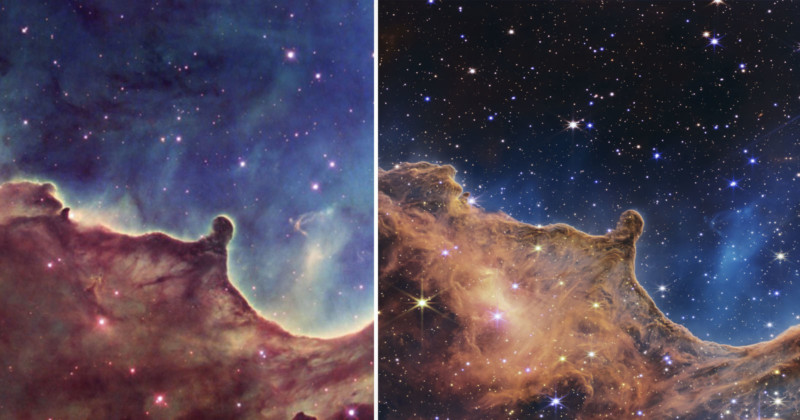
Hubble and Webb Photonics: Nebula captured with both. Left: Hubble, Right: James Webb
These capabilities allow new space telescopes to take detailed photographs of objects nearly impossible to observe from the earth. The pictures shown above exhibit the results of this modern success, but how have photonics changed with the exchange of new space telescopes? Perfect examples of these differences would be the Hubble Space Telescope, and the James Webb Space Telescope.
The Photonics of Hubble Space Telescope
Introduction
The Hubble Space Telescope was the first astronomical observatory placed into earth orbit, about 340 miles from the surface. It was originally launched in 1990 aboard the Space Shuttle Discovery, but a small error with Hubble’s main mirror compromised its capabilities. It was later repaired by a shuttle servicing mission and has been fully operational since 1993. Since then, Hubble has provided immense insight and significant progress toward learning more about our solar system and beyond.
Technology
The human eye is only capable of seeing a small fragment of radiation emitted by surrounding objects, making it impossible to see other forms of radiation around us. This small portion of visible radiation is called visible light, which includes wavelengths from 380 to 700 nanometers. When it comes to space telescopes and deep space exploration, different sections of the electromagnetic spectrum are crucial in providing insight into the bigger picture.
The Hubble Telescope is able to observe Visible, Infrared, and Ultraviolet lightwaves, giving it extreme variety as a large space observatory. The detection of lightwaves in these wavelength domains involves extremely advanced photonics. Hubble has two mirrors, oriented in a Cassegrain Telescope design as shown in the figure below. Once light travels through the length of the telescope, it reflects off the primary mirror towards the secondary mirror. Once the light is concentrated into a single, more compact beam, it is directed towards Hubble’s scientific instruments for analysis.
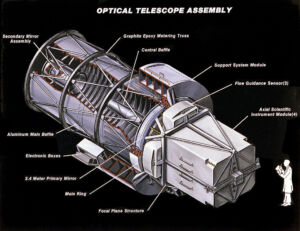
Hubble Optics Diagram
Observations
The photos from the Hubble Telescope have provided humanity with a new perspective of the universe, diving deeper into some of the most riveting cosmic queries. Following years of analysis from astrophysicists and astronomers, Hubble’s discoveries served as a catalyst in the study of galaxies, stars, nebulae, and their complex evolution. The gathered data from this telescope fostered a new era of cosmological studies.
The Photonics of Webb Space Telescope
Introduction
The James Webb Space Telescope is the newest space telescope to date, launched in December 2021 aboard an Ariane-5 Rocket. Aside from NASA’s oversight, Webb’s design and development was also a collaboration between two other groups, the European and Canadian space agencies. It is the largest optical telescope currently in space, primarily designed to conduct infrared astronomy. It arrived at its Sun-Earth Lagrange Point in January of 2022, and the first Webb pictures were released to the press in July.
Technology
Webb is able to observe visible, near-infrared, and mid-infrared wavelengths, making it more specialized in infrared detection. The Webb telescope, much like Hubble, is a reflecting, Cassegrain-designed, telescope with curved mirrors instead of lenses. However, the design in its optics is where the two differ. Webb’s design incorporates a third curved mirror, allowing for better optical performance in comparison to Hubble’s standard two-mirror configuration.
Webb’s primary mirror, as shown in the figure below, consists of eighteen hexagonal segments made with gold-plated beryllium. The gold coating provides infrared reflectivity, and it is covered by a thin layer of glass for additional structural support. The secondary mirror, like Hubble’s, collects reflected lightwaves from the primary mirror and directs them towards the science instruments to be analyzed.
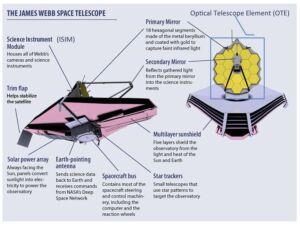
Webb Optics Diagram
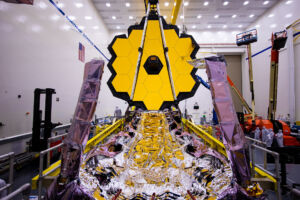
Webb Primary Mirror
Because Webb was designed for infrared astronomy, it can detect extremely faint objects back to redshift =20, signifying a time period about 180 million years after the big bang. Webb’s heightened ability to observe the infrared portion of the electromagnetic spectrum is important for many reasons:
- Very early and distant objects have mostly infrared emissions, making them only visible via this advanced infrared technology.
- Infrared light waves are more visible through dust clouds that could be blocking cosmic objects. Webb’s infrared vision can cut through massive dust and gas clouds with utmost ease.
- Cosmic objects at colder temperatures emit more strongly in infrared.
- Infrared waves are extremely difficult, if not impossible, to view from telescopes stationed on the earth’s surface.
Observations
Webb’s observations will lead to more discoveries than any of its predecessors. It will tell us more about the atmospheres of extrasolar planets, reveal galaxy clusters as they appeared 4.6 billion years ago, and even showcase the collisions of stars and galaxies. Its infrared technology will continue to show humanity things never before seen by another telescope, and it will ultimately lead the way in astronomical advancements.
What’s the Difference: Hubble and Webb Photonics
When comparing the optics of the Hubble Space Telescope and the James Webb Space Telescope, the difference in size speaks for itself. Webb’s primary concave mirror measures a massive 21ft in diameter, easily six times larger than Hubble’s 8ft diameter primary mirror. The larger size allows for a bigger light collecting area, giving Webb an extreme advantage when collecting longer and dimmer light waves.
The analysis of how each telescope observes different light waves is where the difference in photonics truly comes in. Webb’s heightened technology showcases richer infrared views of the universe, easily going beyond any of Hubble’s infrared capabilities. Hubble was first optimized for visible and ultraviolet light, so its photos and collected data slightly differ. Below are both Hubble and Webb’s “deep field” images for comparison.
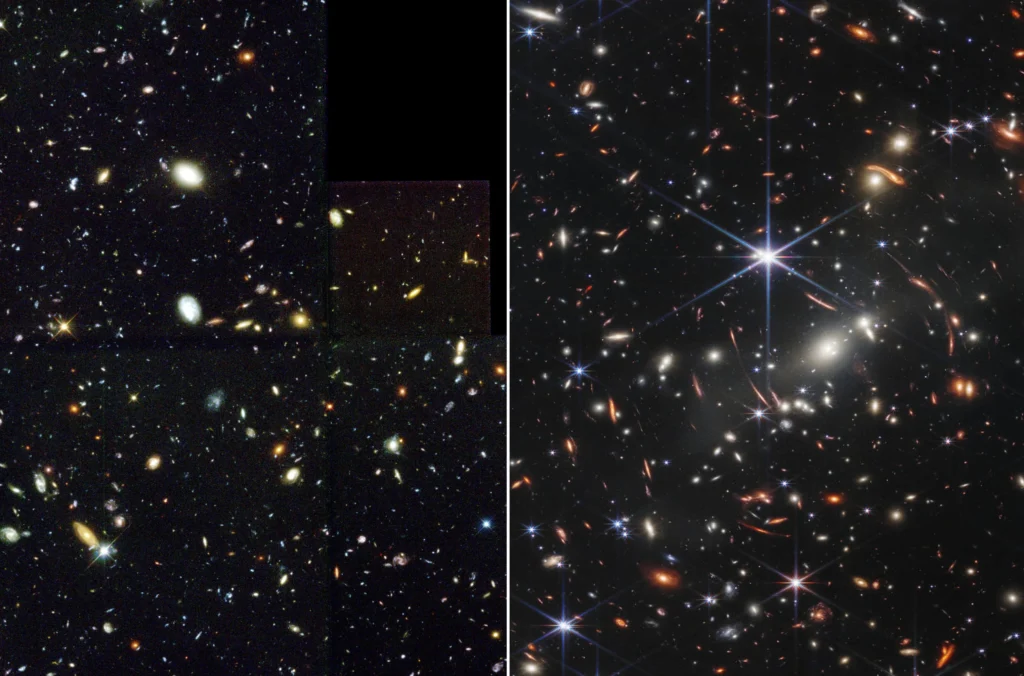
Deep field view of cosmos captured with Hubble (left) and Webb (right) telescopes
At first glance, these photos may seem identical, but with deeper analysis, it is easy to see how much more detail the Webb Telescope is capable of capturing thanks to its infrared technology. It shows the sharpest captured image of our distant universe to date, which proves a promising future during its hopefully twenty-year mission duration.
Hubble and Webb are still an intimidating pair of observatories, a collaboration of data from the two would cover an extensive lightwave range never seen by a single space telescope. With talents combined, they could provide the greatest views of our universe humanity has ever seen.
